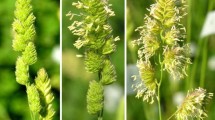Abstract
The opening time of the flower and duration of blooming, as well as the anther opening time and type of pollination, have been studied in five species of the genus Hemerocallis L. under different weather conditions. It is found that weather conditions do not affect the flowering of mesophytic species. Xerophytic species start to bloom later under adverse weather conditions, and the life of their flower increases. The main type of pollination in daylilies is xenogamy, which is combined with geytonogamy. The pollen collected in a sunny weather at an air humidity of 65% is characterized by high vitality.
Similar content being viewed by others
References
Vavilov, N.I., Breeding as the Science, Semenovodstvo, 1934, no. 2, pp. 5–20.
Barkalov, V.Yu., Fam. 144. Hemerocallidaceae R. Br., in Sosudistye rasteniya sovetskogo Dal’nego Vostoka (Vascular Plants of the Soviet Far East), Kharkevich, S.S., Ed., Leningrad: Nauka, 1987, vol. 2, pp. 393–397.
Krestova, I.N., Daylilies in the Russian Far East flora as a source of new cultivars, in 3d Global Botanic Garden Congress, China, Wuhan, 2007. http://www.bgci.org/wuhan/posters. Accessed on March, 2011.
Krestova, I.N. and Nesterova, S.V., Breeding of the members of genus Hemerocallis by cryopreservation of pollen, in Kriokonservatsiya kak sposob sokhraneniya biologicheskogo raznoobraziya, Mater. nauch. konf. “Biofizika zhivoi kletki”, Pushchino (Cryopreservation as the Method of Preservation of Biological Diversity, Proc. Sci. Conf. “Biophysics of Living Cell”, Pushchino), 2008, vol. 9, pp. 72–73.
Krestova, I.N., Effect of different storage conditions on viability of pollen of Far East members of genus Hemerocallis L., Vestn. Krasnoyarsk. Gos. Agrar. Univ., 2009, no. 12, pp. 63–68.
Vyatkin, A.I., A genus Hemerocallis L. in Siberia, Extended Abstract of Cand. Sci. (Biol.) Dissertation, Novosibirsk, 2000.
Chung, M.G. and Kang, S.S., Morphometric analysis of the genus Hemerocallis L. (Liliaceae) in Korea, J. Plant Res., 1994, vol. 107, pp. 165–175.
Noguchi, J. and De-Yuan, H., Multiple origins of the Japanese nocturnal Hemerocallis citrine var. vespertina (Asparagales: Hemerocallidaceae): evidence from noncoding chloroplast DNA sequences and morphology, Int. J. Plant Sci., 2004, vol. 12 (165), no. 1, pp. 219–230.
Vyatkin, A.I., Biology of flowering and fertilization of some species from genus Hemerocallis L., in Mater. 5-i Mezhd. konf. “Problemy dendrologii, tsvetovosdtva, plodovodstva” (Proc. 5th Int. Conf. “Problems of Dendrology, Floriculture, and Fruit Growing”), Yalta, 1997, pp. 30–31.
Noguchi, J., Hong, D.Y., and Grant, W.F., The historical evolutionary development of Hemerocallis middendorfii (Hemerocallidaceae) revealed by non-coding regions in chloroplast DNA, Plant Syst. Evol., 2004, vol. 247, pp. 1–22.
Zainetdinova, G.S. and Mironova, L.N., Day-lilies: Handbook on growing and reproduction, in Zonal’nyi assortiment dlya Respubliki Bashkortostan (Zonal Variability in Bashkortostan Republic), Ufa: Resp. Ucheb.— Nauchn. Metod. Tsentr, 2005.
Ponomarev, A.N., Object and aspects of anthoecology, Vopr. antoekologii (Problems of Anthoecology), Leningrad, 1969, pp. 43–45.
Ponomarev, A.N., Planning and goals of anthoecological studies, Uch. Zap. Perm. Univ., 1970, no. 206, pp. 3–10.
Nitta, K., Hasegawa, M., Miyake, T., Yasumoto, A.A., and Yahara, T., Genetic basis of floral traits contributing to pollination syndromes of night lily (Hemerocallis citrine) and daylily (H. fulva), Jpn. J. Ecol., 2007, vol. 57, pp. 100–106.
Stout A.B. Memorandum on a monograph of the genus Hemerocallis, Herbertia, 1941, vol. 8, pp. 67–71.
Golubinskii, I.N., Biologiya prorastaniya pyl’tsy (Biology of Pollen Germination), Kiev: Naukov Dumka, 1974.
Noks, R.B., Biologiya pyl’tsy (Pollen Biology), Moscow: Agropromizdat, 1985.
Pausheva, Z.P., Praktikum po tsitologii rastenii (Handbook on Plant Cytology), Moscow: Agropromizdat, 1988.
Golubev, F.V., Biological features of species of genus Allium L. at introduction, Cand. Sci. (Biol.) Dissertation, Moscow, 2003.
Agroklimaticheskie resursy Primorskogo kraya (Agroclimatic Resources of Primorskiy Krai), Leningrad: Gidrometeoizdat, 1973.
Turkenya, V.G., Biologicheskie aspekty mikroklimata mussonnoi zony 13 Dal’nego Vostoka (Biological Aspects of Microclimate of Monsoon Area 13 of the Far East), Vladivostok: Dal’nevost. Otd., Akad. Nauk SSSR, 1991.
Mironova, L.N., Yaponskii irisy. Ekologo-biologicheskie osobennosti introduktsii Iris ensata Thunb. i ego sortov na yuge Primorskogo kraya (Japanese iris: Ecological and biological features of introduction of Iris ensata Thunb. and its sorts in south of Primorskiy krai), Vladivostok: Dal’nauka, 2008.
Yan Sun, Tsarenko, N.A., and Nesterova, S.V., Blooming and ecology of pollination of Gentiana scabra Bunge (Gentianaceae Dumort.) in the south of Primorsky krai of Russia Contemp. Probl. Ecol., 2010, vol. 3, no. 6, pp. 693–697.
Yan Sun, Tsarenko, N.A., and Nesterova, S.V., Flowering and Ecology of Pollination of Gentiana scabra Bunge (Gentianaceae Dumort.) in the South of Primorsky Territory of Russia, Sib. J. Ecol., 2010, vol. 17, no. 6, pp. 947–953.
Lepilov, S.M. and Lepilova, L.A., Several questions of biology of flowering and pollination of cultured Hemerocallis hybryda hort., in Mater. nauch.-prakt. konf. “Innovatsionnye podkhody v selektsii tsvetochnodekorativnykh, subtropicheskikh i plodovykh kul’tur” (Proc. Sci.-Pract. Conf. “Innovation Approaches in Breeding of Flowering-Decorative, Subtropical, and Fruit Cultures”), Sochi: Vseross. Inst. Tsvetovod. Subtrop. Kult., 2005, pp. 38–44.
Poletiko, O.M., Day-Lilies (Hemerocallis L.) and their decorative importance, in Introduktsiya rastenii i zelenoe stroitel’stvo (Introduction of the Plants and Green Constructions), Moscow, 1950, pp. 27–54.
Fedorov, A.A. and Artyushenko, Z.T., Atlas po opisatel’noi morfologii vysshikh rastenii. Tsvetok (Atlas on Descriptive Morphology of Higher Plants: A Flower), Moscow: Nauka, 1975, pp. 21–87.
Kudryashova, G.L., Family Hemerocallidaceae, in Zhizn’ rastenii: v 6 tomakh (Life of the Plants) Takhtadzhyan, A.L., Ed., 6 vols., 1982, vol. 6, pp. 102–104.
Sedel’nikova, L.L., Biomorfologiya geofitov v Zapadnoi Sibiri (Biomorphology of Geophytes in Western Siberia), Novosibirsk: Nauka, 2002.
Author information
Authors and Affiliations
Corresponding author
Additional information
Original Russian Text © I.N. Krestova, S.V. Nesterova, 2013, published in Sibirskii Ekologicheskii Zhurnal, 2013, No. 4, pp. 593–602.
Rights and permissions
About this article
Cite this article
Krestova, I.N., Nesterova, S.V. Flowering and pollination of the native daylily species (Hemerocallis) in the Botanical Garden Institute, Far East Branch, Russian Academy of Sciences. Contemp. Probl. Ecol. 6, 448–454 (2013). https://doi.org/10.1134/S1995425513040057
Published:
Issue Date:
DOI: https://doi.org/10.1134/S1995425513040057




